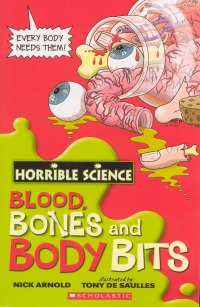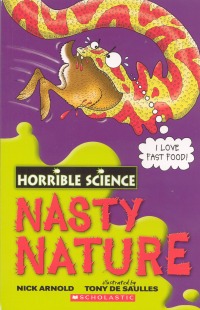| ________________
CM . . .
. Volume XV Number 6. . . .November 7, 2008
excerpt:
Nick Arnold's "Horrible Science" series is certain to appeal to boys and girls with a fascination for trivia, particularly scientific trivia that is presented in weird and outlandish ways. Similar to the excerpts above, Blood, Bones and Body Bits and Nasty Nature are filled with pieces of information that make the human body and Earth's animal inhabitants and, dare I suggest, science, more fascinating than most preteens likely imagine. Arnold doesn't merely list bits of factual information in the most revolting way he can imagine, though there is an abundance of language that will appeal to adolescents' fondness for gross and disgusting vocabulary. He contextualizes much of the information he presents. In some sections, questions are posed, case studies are presented, and the reader is asked to either predict the outcome or answer a series of questions based on the information provided. In other sections, the reader is presented with either events or stories from the history of science that introduce and begin to develop an understanding of concepts like immunity, vaccination, animal communication, enzymes, classification, gastric juices and digestion. Arnold also makes use of tests and quizzes, some of which the student readers are to ask their teachers, fact files, warnings, manuals, guides, diagrams, suggestions for experiments, and text boxes with the heading "Bet you never knew!" Each book concludes with a seven page quiz "To find out if you're a Nasty Nature or Blood, Bones and Body Bits expert" plus a thorough "horrible index." Recommended. Barbara McMillan is a teacher educator and professor of science education in the Faculty of Education, the University of Manitoba.
To comment
on this title or this review, send mail to cm@umanitoba.ca.
Copyright © the Manitoba Library Association. Reproduction for personal
use is permitted only if this copyright notice is maintained. Any
other reproduction is prohibited without permission.
NEXT REVIEW |
TABLE OF CONTENTS FOR THIS ISSUE
- November 7, 2008.
AUTHORS |
TITLES |
MEDIA REVIEWS |
PROFILES |
BACK ISSUES |
SEARCH |
CMARCHIVE |
HOME |

